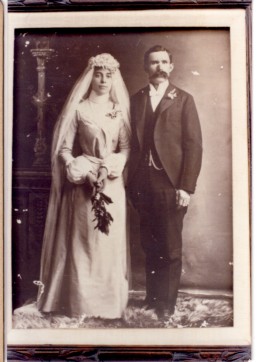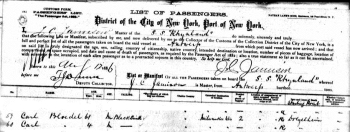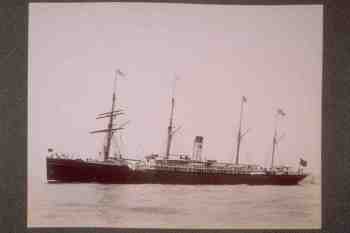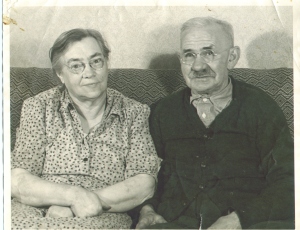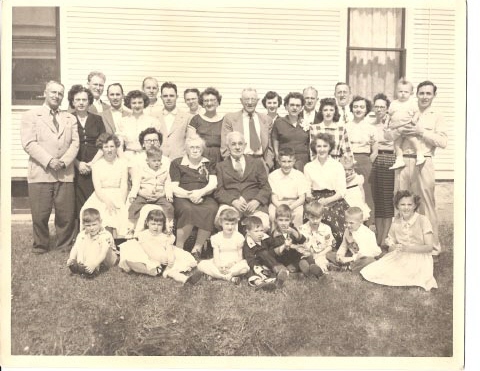Since I’ve been on the subject of the Struck family and their emigration to America, I thought I’d take a closer look at the Birkholz family history. If you’ll forgive me going off topic for a moment, it was a bit unusual for the Struck family to emigrate so late in the 19th century. In just one decade (1880-89) over 1.5 million Germans had come to America. But in 1891 US Congress had enacted much stricter immigration laws, and that number had dropped to less than 1/3 of the previous decade. Many Americans believed that immigrants were a threat to national security (both financially and in terms of public health) and there was not only overt hostility but actual attacks on immigrants. In addition, just as they prepared to leave Germany, America was still in the midst of the Panic of 1893, the worst economic depression to occur in the US before 1929.
That same Immigration Act of 1891 created stricter laws on health and financial security. Immigrants had to prove that they were of good health and had good job prospects to enter the US. It is estimated that an immigrant would need to save at least $1200 toward the purchase of land and farming equipment to get started in America, an enormous amount of money in those days! So it must have taken an immense amount of courage and desire for a family to uproot everything and move to this new country.
There is one benefit to the timing of their emigration: US records from 1880 on are more thorough and complete than earlier records. By this time the census takers began recording the names, ages and occupations of all the members of the household, which provides us with a veritable treasure of insights into the lives of this family.
As we learned earlier from the ship manifest, the Birkholz family came to America with three young children: Carl (4), Helene (3), and Emma (2). Luckily, a federal census was taken just five years later (in 1900) so we can see how this family is faring. It appears they are renting a home in the village of Menomonee Falls, and father Friedrich Birkholz is working as a laborer in the local quarry. He’s not alone: all along the street we see that his neighbors are also recent immigrants from Germany, and employed at the same work. In fact, our great-grandfather Frank Struck is living with the Birkholz family and working at the quarry as well.
One interesting tidbit: while all the adults are listed as being able to read and write, only Friedrich and Frank are able to speak English, unlike Wilhelmina and her mother Carolina. Here is a partial transcript of their census entry:
Fredrick Birkholz – head – age 35
Minnie Birkholz – wife – age 35
Hellen Birkholz – daughter – age 9
Emma Birkholz – daughter – age 8
Charles Birkholz – son – age 3
Ernist Birkholz – son – age 1
Frank Struck – boarder – age 26
Charles Wagner – boarder – age 25
Caroline Struck – boarder – age 69
As you can see, two more children have been born: Charles and Ernest. There is one person missing from this list: their eldest son, Carl. He would have been about 10 years old at this time, and while it may be possible that he is living with another family member (which I have not found via census searches), sadly the most likely explanation is that he passed away sometime shortly after their arrival in America. It seems a bit corroborative of this theory that they named their first son born on US soil Carl (Charles) as well. But one odd note: the census taker asked how many children this couple had, and how many are living, and the written response is 4 (all living). However, as you’ll see in a future post there are plenty of reasons why this might have been a recording error.
We then move forward five more years, to 1905, when a Wisconsin state census is taken. Friedrich is still working as a laborer and renting his home in Menominee Township. Frank Struck has moved on (he married in 1901 and started his own family). The Birkholz family has added to their numbers significantly: with Franz, Otto, and Ruth born in these five short years. There is again a child missing – Helen – but she is “rediscovered” in a later census. Where she is at the age of 15 is only speculative at this point, as extensive searching of the surrounding area has not identified her yet. It could be that she was living with relatives, working as a servant, or she may have been somehow missed by the census-taker. (Update: see bottom of post for a possible discovery on Helen’s whereabouts.)
The next federal census is in 1910, and much has changed again in the five year span. Their son Otto is missing from this census, so it appears that sadly they have lost another young child. We do find a 19-year-old Helen again living with the family, and a clue to where she has been: her occupation is listed as domestic for a private family. There is a marked improvement for the family as a whole, however: Friedrich has purchased his own farm in nearby Lisbon Township!
 The family endures yet more tragedy in January 1914, according to this news article posted in the Waukesha Freeman.
The family endures yet more tragedy in January 1914, according to this news article posted in the Waukesha Freeman.
Apoplexy is an old fashioned term for a stroke, although I do wonder if this was actually a choking incident? There is one little clue in this news account that corroborates the question of Otto Birkholz’s fate: it says that Emma is survived by three brothers, which would be Charles, Ernest and Frank.
Emma is buried in the family plot in Sunnyslope Cemetery, Menomonee Falls alongside her parents and brother Frank. The final resting place of the remainder of the family has yet to be determined.
We’ll now jump forward six years to the 1920 census. Four of the Birkholz children are still living with their parents on the farm. Charles, now 23, is working as a machinist at a gasoline company. 21-year-old Ernest is a laborer with the railroad. And 19-year-old Frank is helping his father on the dairy farm. Their youngest, Ruth, is only 15 and in school. Their oldest living child, Helen, is now 30 years old and most likely married. Incidentally, a relative – Carl Struck – has a dairy farm himself just down the street.
One year after the census, their grandmother Carolina Struck passed away at the age of 90 (see her death notice in a previous post). Her daughter Wilhelmina Struck-Birkholz died a few years later, in 1926. Her husband Friedrich followed in 1929.
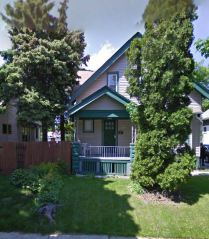 1930 is the final year that the census is available at this time, and it appears the farm has been sold with their father’s passing and the children scattered, since I cannot find any evidence of the Birkholz family living in the Menomonee Falls area. I found a listing for Charles in Milwaukee; he has purchased a home in the city, where his new bride Irene and his younger sister Ruth are living with him. He is working as a machinist at an electrical control firm, and his sister is a drill press operator for the same company.
1930 is the final year that the census is available at this time, and it appears the farm has been sold with their father’s passing and the children scattered, since I cannot find any evidence of the Birkholz family living in the Menomonee Falls area. I found a listing for Charles in Milwaukee; he has purchased a home in the city, where his new bride Irene and his younger sister Ruth are living with him. He is working as a machinist at an electrical control firm, and his sister is a drill press operator for the same company.
 Charles Birkholz’s home in Milwaukee.
Charles Birkholz’s home in Milwaukee.
His brother Ernest has rented an apartment just four miles away and is working as a truck driver for a hardware store; his wife of four years is an assembler at an auto parts factory.
Ernest’s rented home in Milwaukee.
I was unable to find Frank on this census, although a news article I discovered in the Waukesha Freeman, dated July 1951, marks the final information recorded for this family.

As far as I am aware, the Struck and Birkholz families did not much keep in touch over the years after Wilhelmina’s passing. It seems that the Birkholz family endured plenty of hardships as immigrants to this country, but they were able to achieve their dream of buying a family farm, and their children were afforded a good education that allowed them to make their own way in the world successfully… which is no small matter to a family who came to this country during a difficult time and worked hard to achieve their goals.
Update: While researching related family members, I found the following entry in the 1905 census, which quite possibly could be Helen:

As you see, the age and surname match, and she is living in the Menominee area, although the lack of a first name makes it difficult to be certain.

